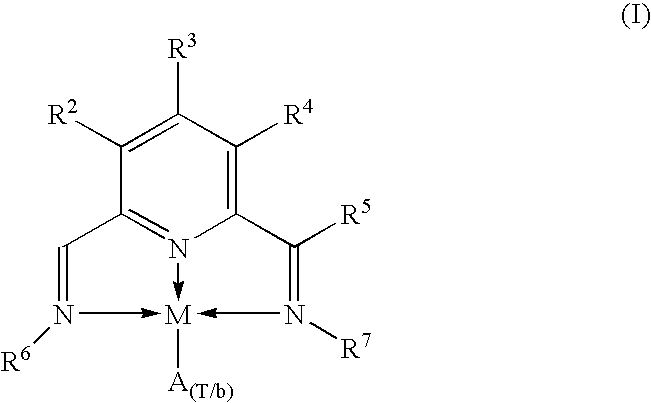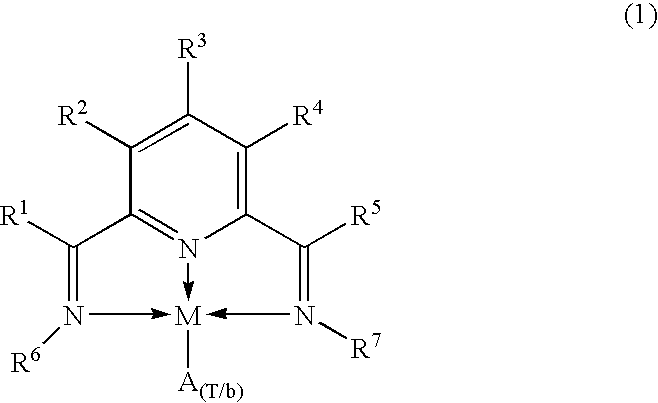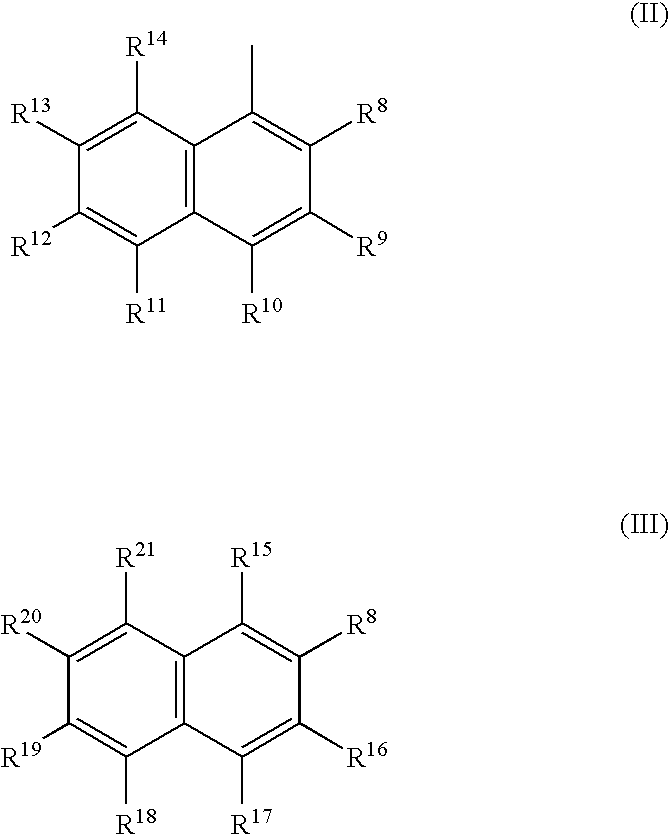Catalytic complexes and their use for polymerizing alpha-olefins
a technology of catalytic complexes and polyethylenes, applied in the field of catalytic complexes and their use for polymerizing alpha-olefins, can solve the problems of low molecular weight of polyethylene obtained, the catalytic activity of the complex is described, and the catalytic activity of the complex is not efficien
- Summary
- Abstract
- Description
- Claims
- Application Information
AI Technical Summary
Problems solved by technology
Method used
Image
Examples
example 1
Synthesis of {2,6-bis(1-(2-Methyl-1-naphthylimino)ethyl]pyridine-.kappa..sup.3 :N,N',N"}FeCl.sub.2 (Compound 1).
a) Synthesis of 1-Amino-2-methylnaphthalene
10 g (53.42 mmol) of 2-methyl-1-nitronaphthalene dissolved in 125 ml of methanol and 0.57 g (0.057 g of Pd, 0.54 mmol) of palladium on activated charcoal were introduced successively into an autoclave.
The suspension was heated to 50.degree. C. during 4 hours under a pressure of 10.times.10.sup.5 Pa of hydrogen, then filtered at ambient temperature. The solution obtained was evaporated and distilled in vacuo. This gave 6.7 g of 1-amino-2-methylnaphthalene in the form of a yellow oil with a boiling point of between 145 and 150.degree. C. at 133.3 Pa.
.sup.1 H NMR (CDCl.sub.3 -300K-500 MHz) .delta.=2.40 (s, 3H, --CH.sub.3), 4.15 (s, broad, 2H, --NH2), 7.33 (d, 2H, H.sub.3 naphth, .sup.3 J.sub.H3-H4.about.8 Hz), 7.28 (d, 2H, H.sub.2 naphth), 7.47 (m 2H, H.sub.6-7 naphth) 7.82 (m, 2H, H.sub.8-5 naphth) in ppm.
b) Synthesis of 2,6-bis(1-(...
example 2
Synthesis of {2,6-bis[1-(2-Methyl-1-naphthylimino)methyl]pyridine-.kappa..sup.3 :N,N',N"}FeCl2 (Compound 2).
a) Synthesis of 2,6-bis[(2-Methyl-1-naphthylimino)-methyl]pyridine.
Step b of Example 1 was repeated, but using 1.00 g (7.41 mmol) of 2,6-diformylpyridine and 3.2 g (22.35 mmol) of 1-amino-2-methylnaphthalene dissolved in 20 ml of ethanol, without adding glacial acetic acid during mixing, and purifying with a 20 / 80 AcOEt / n-hexane mixture as eluent. This gave 890 mg of a golden yellow solid.
.sup.1 H NMR (CDCl.sub.3 -300K-500 MHz) .delta.=2.40 (s, 6H, --CH.sub.3 naphthyl) 7.42 (m, 6H, H.sub.naphth), 7.62 (d, 2H, H.sub.naphth), 7.85 (m, 4H, H.sub.naphth), 8.11 (t, 1H, H.sub.p py, .sup.3 J.sub.Hm-Hp.about.7 Hz), 8.62 (d, 2H, H.sub.m py, .sup.3 J.sub.Hm-Hp.about.8 Hz), 8.80 (s, 2H, H.sub.iminoformyl) in ppm.
b) Synthesis of Compound 2.
Step c of Example 1 was repeated, but using 180 mg of activated ferrous chloride and 600 mg of 2,6-bis[(2-methyl-1-naphthylimino)methyl]pyridine. This ...
example 3
Synthesis of {2,6-bis[1-(1-Anthracenylimino)ethyl]pyridine-.kappa..sup.3 :N,N',N")FeCl.sub.2 (Compound 3).
a) Synthesis of 2,6-bis[1-(1-Anthracenylimino) Ethyl]-pyridine
0.70 g (4.29 mmol) of 2,6-diacetylpyridine dissolved in 40 ml of ethanol were introduced under nitrogen into a 250 ml round-bottomed flask. The mixture was heated at reflux and stirred.
2.5 g of 1-aminoanthracene (purchased from Aldrich) dissolved in 80 ml of ethanol were then added dropwise, followed by 0.2 ml of glacial acetic acid.
After 60 hours of stirring at reflux, the mixture was cooled to ambient temperature; the solid was filtered and dried in vacuo, giving 2.1 g of 2,6-bis[1-(1-anthracenylimino)ethyl]pyridine in the form of a yellow powder.
.sup.1 H NMR (CDCl.sub.3 -300K-500 MHz) .delta.=2.50 (s, 6H, --CH.sub.3), 6.84 (d, 2H, H.sub.2 anthr, .sup.3 J.sub.H2-H3.about.7 Hz), 7.48 (m, 6H, H.sub.anthr), 7.84 (d, 2H, H.sub.anthr), 7.99 (d, 2H, H.sub.anthr), 8.03 (d, 2H, H.sub.anthr), 8.12 (t, 1H, H.sub.p py, .sup.3 ...
PUM
| Property | Measurement | Unit |
|---|---|---|
| Percent by mass | aaaaa | aaaaa |
| Mass | aaaaa | aaaaa |
| Weight | aaaaa | aaaaa |
Abstract
Description
Claims
Application Information
 Login to View More
Login to View More - R&D
- Intellectual Property
- Life Sciences
- Materials
- Tech Scout
- Unparalleled Data Quality
- Higher Quality Content
- 60% Fewer Hallucinations
Browse by: Latest US Patents, China's latest patents, Technical Efficacy Thesaurus, Application Domain, Technology Topic, Popular Technical Reports.
© 2025 PatSnap. All rights reserved.Legal|Privacy policy|Modern Slavery Act Transparency Statement|Sitemap|About US| Contact US: help@patsnap.com



